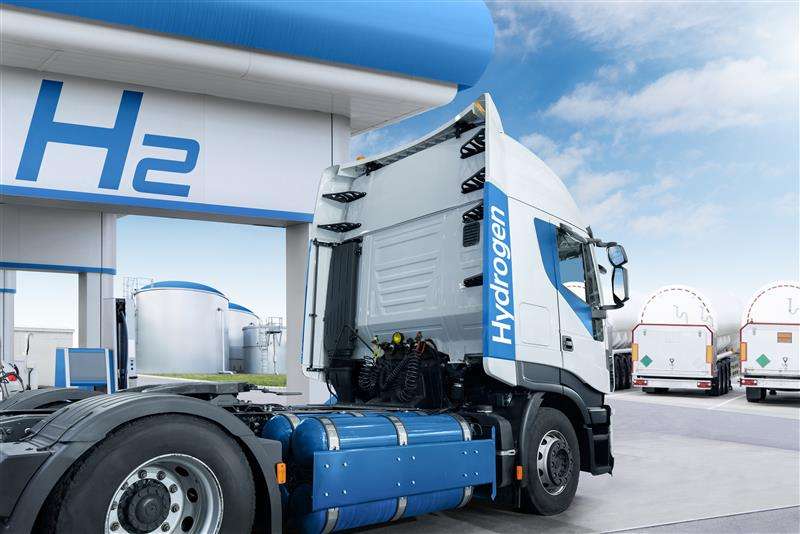We’ve come a long way in decarbonizing the transport sector, largely thanks to the development of lithium-ion batteries (LIBs). Ubiquitous in our rechargeable laptops, phones, and lawnmowers, Li-ion technology has been scaled up sufficiently to power almost all the electric vehicles (EVs) we see on our roads today. With charging infrastructure becoming increasingly accessible, lithium-ion batteries have emerged as the leading technology in green transport – at least for now.
However, as we move forward, the dominance of LIB technology may well change. Within industrial and commercial transportation, forklift trucks, buses, and long-distance trucks, hydrogen fuel cells (HFCs) are making a serious impact. And rather than being a competing technology, the differences between HFCs and LIBs have meant that both play their part in decarbonizing the mobility sector, with Li-ion used primarily in passenger vehicles and HFC used where long-ranges with fast refueling times are essential for the successful switch from fossil fuels.

As with Lithium-ion battery technology, HFC technology is under constant development, attracting a lot of funding from governments and private sector alike. Within the transportation sector, Fuel Cell Electric Vehicles (FCEVs) show much larger ranges than LIBs, and refueling times are relatively low. For example, in January 2024, the Nikola Corporation launched hydrogen powered trucks in the US with a range of 500 miles with an estimated refueling time of only 20 minutes.
HFCs are also routinely powering forklift trucks within warehouses, providing the power needed to shift heavy weights. And HFCs are even beginning to power trains in regions where electrification is out of reach due to either impractical or economic reasons.
The entire global fuel cell market (incorporating transportation, commercial and industrial, residential, data center, defense, utilities, and government) is expected to grow at a huge CAGR of 27.1% from 2024 to 2030. In 2023, the transport sector alone was worth USD 3.53 billion.
The predicted growth in demand for HFCs within the mobility sector is expected to be driven by the increased use of heavy-duty trucks and buses, and for new commercial and industrial applications, such as aviation and shipping. HFCs are seen to be the superior technology for these applications as lithium-ion batteries simply do not hold enough charge to cope with the long distances between charging or refueling within shipping and aviation.
However, despite many applications and a healthy outlook for the HFC sector, there are many challenges facing hydrogen fuel cell technology, such as maintaining high quality during production and building a reliable refueling infrastructure. The corrosive and flammable nature of hydrogen itself brings extra risk, requiring specialist transportation and storage facilities.
Hydrogen fuel cells for use in electric vehicles use a proton-conducting polymer membrane as the electrolyte, and these cells are called Proton Exchange Membrane fuel cells, or PEMs.
Like batteries, PEMs contain an anode, a cathode, and an electrolyte. The basic reaction is that hydrogen is converted into H+ ions at the anode and oxygen is converted into O- at the cathode. The hydrogen and oxygen ions combine to produce water.
Both electrodes require a catalyst to create the ions. The catalyst is applied as a thin layer on the PEM surface. On the anode side, the catalyst used is typically platinum or iridium, and the cathode side uses nickel. The coating thickness, purity, and uniformity are essential for the correct operation of the fuel cell over its lifetime. Iron contamination specifically is an issue if present in the fuel cell as it then reacts with hydrogen peroxide and forms free radicals in the Fenton reaction (shown below).
Fenton reaction: Fe2+ + H2O2 → Fe3+ + HO. + OH-
H2O2 + HO. → HO2. + H2O
This reaction can damage the cell’s ion-exchange membrane and lead directly to the deterioration of the fuel cell itself.
Therefore, it’s essential to monitor both the integrity of the platinum and iridium coating layer AND scan for the presence of iron particles (and other metal contaminants) of the membrane electrode assemblies (MEAs).
The EA8000 analyzer combines X-ray transmission technology, optical microscopy, and x-ray fluorescence (XRF) spectrometry to locate and characterize metal contaminants within MEAs.
Easy to set up and fast to scan the components, the EA8000 is revolutionary in battery quality control, returning a topological map of the electrode surface highlighting the position and composition of any metal particles present – allowing the user to predict battery performance and longevity.
Find out more:
Download the application note for detailed examples of the use of the EA8000 in PEM analysis.
For essential catalyst coating thickness and coating weight measurements, the benchtop XRF LAB-X5000 or handheld X-MET8000 XRF analyzers deliver fast, accurate, and precise platinum and iridium coating weight in a completely non-destructive test. Both instruments are suitable for a high-throughput production environment.
Download the application notes for detailed use of the LAB-X5000 benchtop XRF analyzer and X-Met8000 handheld analyzer for platinum coating weight analysis.